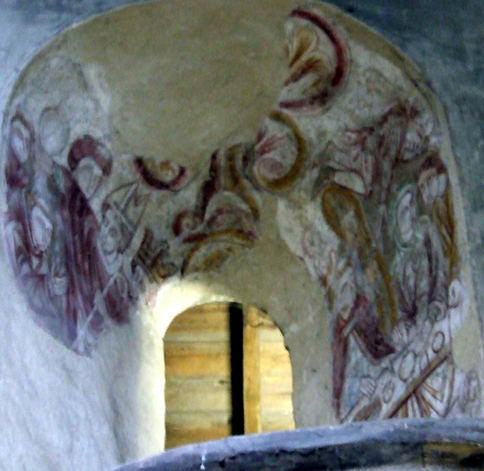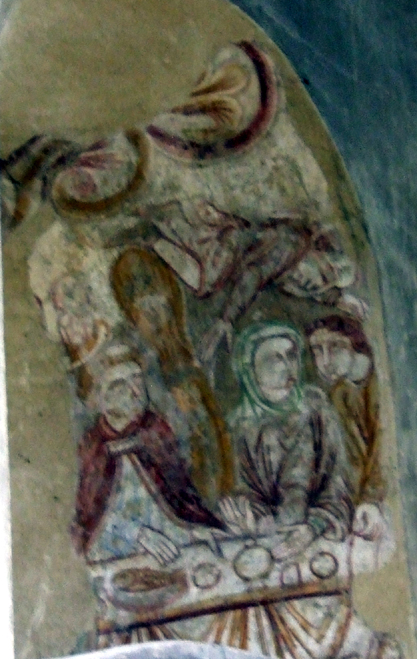Pittington, Co. Durham (†Durham) c.1175-1200
Scenes from the Life of St Cuthbert

St Cuthbert (c.634-687), a native Englishman and monk who eventually became prior and later bishop of Lindisfarne is by far the most famous saint of northern England. This is the sole surviving set of paintings (hearsay evidence suggests that there were once many more) in this church, and indeed, Durham cathedral apart, in county Durham. (I would be happy to be proved wrong on this, so please contact me if you know of any others). They are in the splays of a window at the west end of the church.
At the right is a complete view of the window aperture and its splays. In the centre of the arch, above the aperture, is some very elaborate foliated scrollwork which may be intended symbolically for vines – it resembles quite closely the detail below the figure of a prophet at Little Easton. This kind of beautifully controlled, flowing detail is typical of very high quality early decorative work.
The enlarged detail at the left below shows the scene in the left-hand splay of the window, where Cuthbert is consecrated bishop (Cuthbert is the tonsured figure kneeling at the left, having the holy oil poured over his head by Archbishop Theodore). The crowned man at the far right of the scene is probably King Egfrith of Northumbria, who was present at the consecration in York.

More than any others in the English parish church, it seems to me, the Pittington paintings show the final achievement of a fully English Romanesque style, short-lived as this turned out to be. The eyes are large and basically almond in shape, but the figures have lost the remote and rather chilly icon-like quality found in so much Continental Byzantine art. The only possible comparison is with the contemporary painting of St Cuthbert at Durham cathedral, and for once the similarities are so marked that it seems safe to say that the same hand painted them both. Pittington is only a few miles from Durham city.
At the right is the painting in the right-hand splay of the window, the only depiction known to me of St Cuthbert’s vision at the table of Abbess Aelfleda of Whitby, a close friend whom he visited more than once. The story behind this narrative painting is in Bede’s Life of Cuthbert, and a version of it can be found in Chapter XXXIV of the Medieval Sourcebook.

Cuthbert, who had by this time become Bishop of Lindisfarne, and Aelfleda met on this occasion on Coquet island off the coast of Northumberland. The photograph shows the moment when, eating at Aelfleda’s table, the knife fell from his hand as he saw in a vision ‘the soul of a holy man’ being taken to Heaven. There is more scrollwork at the top of this painting, and below that the holy man’s soul painted as a small figure lying horizontally across the space, head at the right, legs in the air and one hand extended downwards. The saint’s story relates that at that moment, a messenger came in with the news that one of Aelfleda’s servants had fallen to his death from a tree.
This messenger is the young man in a light brown tunic at the far right of the scene, his hand on the table, speaking to Aelfleda, who wears a green veil around her head and raises her right hand from the table in shock. A tall man, also in brown, stands behind, and then comes Cuthbert in a red cloak, his left hand gripping the edge of the table as the truth of his vision is confirmed. The table is set with a fish on a dish, a cup for wine or other drink, and bread. The draped table and the robes of those sitting at it show the elegantly looping ‘dampfold’ modelling characteristic of the best Romanesque painting. The frozen moment is beautifully captured in an anonymous masterpiece that is in no way inferior to the paintings in Durham cathedral, or indeed anywhere else in England at this period.
A contemporary of Cuthbert, the monk and hagiologist Reginald of Durham declared that the three most popular saints in England were Cuthbert, Edmund and Etheldreda. All three had bodies found to be incorrupt long after their deaths, a phenomenon always regarded as a sign of great sanctity in the Middle Ages. Given the sheer quality of these paintings, it is a great pity that none of the others said to have been at Pittington have survived.
Website for St Laurence, Pittington